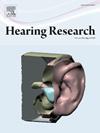Measurement of phase-locked neural responses to cochlear-implant stimulation from multiple stages of the auditory system
IF 2.5
2区 医学
Q1 AUDIOLOGY & SPEECH-LANGUAGE PATHOLOGY
引用次数: 0
Abstract
Studies investigating objective measures of auditory perception when using cochlear implants (CIs) differ in the stimuli used and in the neural response measured. The present study aims to disentangle the effects of response type and of stimulus type on neural response properties. We report three measures corresponding with separate neural latencies, all collected from the same 19 CI recipients and with the same stimulus, consisting of a continuous low-rate electrical pulse train of about 40 pulses per second (pps). These measures comprise the electrically evoked compound action potential (eCAP), auditory brainstem response (eABR), and auditory steady-state response (eASSR), having putative neural generators in peripheral (auditory nerve), subcortical (brainstem), and thalamo-cortical auditory regions, respectively. When assessing correlations across CI recipients, we found that the growth of eASSR amplitude with stimulus level was correlated with that of eCAP amplitude and predictive of the just-noticeable-to-comfortable electrical dynamic range, as measured through behavioral loudness scaling. Additionally, we compared eASSRs measured with the ∼40-pps stimulus and with a high-rate (500-pps) pulse train modulated in amplitude at rates around 40 Hz, and found that both showed similar recipient-specific effects of stimulation rate on response phase and amplitude. Our results highlight that neural responses to different electrical stimuli and at different central processing stages share common idiosyncratic properties, and support the validity of eASSRs for loudness-growth estimation in CI recipients.
从听觉系统的多个阶段测量对人工耳蜗刺激的锁相神经反应
研究使用人工耳蜗(CIs)时听觉感知的客观测量在使用的刺激和测量的神经反应方面有所不同。本研究旨在厘清反应类型和刺激类型对神经反应特性的影响。我们报告了三个与不同的神经潜伏期相对应的测量,所有这些测量都来自相同的19个CI受者和相同的刺激,由大约每秒40次脉冲(pps)的连续低速率电脉冲序列组成。这些测量包括电诱发复合动作电位(eCAP)、听觉脑干反应(eABR)和听觉稳态反应(eASSR),分别在外周(听神经)、皮层下(脑干)和丘脑-皮层听觉区有假定的神经发生器。在评估CI受者之间的相关性时,我们发现eASSR振幅随刺激水平的增长与eCAP振幅的增长相关,并预测了通过行为响度量表测量的刚好可注意到舒适的电动态范围。此外,我们比较了用~ 40-pps刺激和高速率(500-pps)脉冲序列以约40 Hz的幅度调制测量的eASSRs,发现两者都显示出类似的刺激速率对反应相位和幅度的受体特异性影响。我们的研究结果强调了不同电刺激和不同中枢处理阶段的神经反应具有共同的特质,并支持了eASSRs对CI接受者响度增长估计的有效性。
本文章由计算机程序翻译,如有差异,请以英文原文为准。
求助全文
约1分钟内获得全文
求助全文
来源期刊

Hearing Research
医学-耳鼻喉科学
CiteScore
5.30
自引率
14.30%
发文量
163
审稿时长
75 days
期刊介绍:
The aim of the journal is to provide a forum for papers concerned with basic peripheral and central auditory mechanisms. Emphasis is on experimental and clinical studies, but theoretical and methodological papers will also be considered. The journal publishes original research papers, review and mini- review articles, rapid communications, method/protocol and perspective articles.
Papers submitted should deal with auditory anatomy, physiology, psychophysics, imaging, modeling and behavioural studies in animals and humans, as well as hearing aids and cochlear implants. Papers dealing with the vestibular system are also considered for publication. Papers on comparative aspects of hearing and on effects of drugs and environmental contaminants on hearing function will also be considered. Clinical papers will be accepted when they contribute to the understanding of normal and pathological hearing functions.
 求助内容:
求助内容: 应助结果提醒方式:
应助结果提醒方式:


